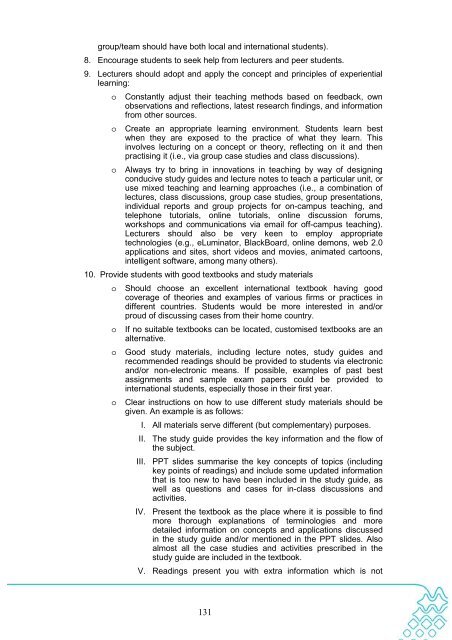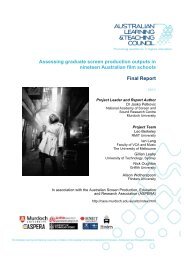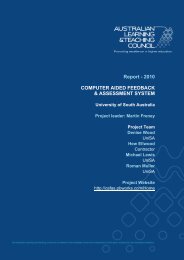group/team should have both local <strong>and</strong> international students).8. Encourage students to seek help from lecturers <strong>and</strong> peer students.9. Lecturers should adopt <strong>and</strong> apply the concept <strong>and</strong> principles of experientiallearning:o Constantly adjust their teaching methods based on feedback, ownobservations <strong>and</strong> reflections, latest research findings, <strong>and</strong> in<strong>for</strong>mationfrom other sources.o Create an appropriate learning environment. Students learn bestwhen they are exposed to the practice of what they learn. Thisinvolves lecturing on a concept or theory, reflecting on it <strong>and</strong> thenpractising it (i.e., via group case studies <strong>and</strong> class discussions).o Always try to bring in innovations in teaching by way of designingconducive study guides <strong>and</strong> lecture notes to teach a particular unit, oruse mixed teaching <strong>and</strong> learning approaches (i.e., a combination oflectures, class discussions, group case studies, group presentations,individual reports <strong>and</strong> group projects <strong>for</strong> on-campus teaching, <strong>and</strong>telephone tutorials, online tutorials, online discussion <strong>for</strong>ums,workshops <strong>and</strong> communications via email <strong>for</strong> off-campus teaching).Lecturers should also be very keen to employ appropriatetechnologies (e.g., eLuminator, BlackBoard, online demons, web 2.0applications <strong>and</strong> sites, short videos <strong>and</strong> movies, animated cartoons,intelligent software, among many others).10. Provide students with good textbooks <strong>and</strong> study materialso Should choose an excellent international textbook having goodcoverage of theories <strong>and</strong> examples of various firms or practices indifferent countries. Students would be more interested in <strong>and</strong>/orproud of discussing cases from their home country.o If no suitable textbooks can be located, customised textbooks are analternative.o Good study materials, including lecture notes, study guides <strong>and</strong>recommended readings should be provided to students via electronic<strong>and</strong>/or non-electronic means. If possible, examples of past bestassignments <strong>and</strong> sample exam papers could be provided tointernational students, especially those in their first year.o Clear instructions on how to use different study materials should begiven. An example is as follows:I. All materials serve different (but complementary) purposes.II. The study guide provides the key in<strong>for</strong>mation <strong>and</strong> the flow ofthe subject.III. PPT slides summarise the key concepts of topics (includingkey points of readings) <strong>and</strong> include some updated in<strong>for</strong>mationthat is too new to have been included in the study guide, aswell as questions <strong>and</strong> cases <strong>for</strong> in-class discussions <strong>and</strong>activities.IV. Present the textbook as the place where it is possible to findmore thorough explanations of terminologies <strong>and</strong> moredetailed in<strong>for</strong>mation on concepts <strong>and</strong> applications discussedin the study guide <strong>and</strong>/or mentioned in the PPT slides. Alsoalmost all the case studies <strong>and</strong> activities prescribed in thestudy guide are included in the textbook.V. Readings present you with extra in<strong>for</strong>mation which is not131
covered (or not covered well) in the textbook <strong>and</strong> study guide.11. Take a balanced teaching <strong>and</strong> learning approacho A combined student-centred <strong>and</strong> lecturer-centred approach should beadopted, especially <strong>for</strong> first year (or first semester/trimester)international students.o Students should be given sufficient training <strong>and</strong> opportunities tounderst<strong>and</strong> <strong>and</strong> learn about the student-centred approach.o Emphasise the importance of correct referencing practices <strong>and</strong> theconsequences of poor/wrong practices.o Stress the importance of presentation, communication <strong>and</strong>interpersonal skills, <strong>and</strong> provide sufficient training to students,especially newly-arrived international students.o Students should be encouraged to participate in class discussions,which could be made compulsory. To facilitate <strong>and</strong> nurture theirconfidence in taking part in class discussions, lecturers should createan environment in which international students feel com<strong>for</strong>table toexpress their ideas, <strong>for</strong> instance, by asking questions they cananswer or are interested in, asking their opinions in relation to theirbackground <strong>and</strong> experiences, continually communicating to them thatparticipation <strong>and</strong> contributing to the class are what matter, notwhether their answers are correct or are in line with those of lecturersor other students.o Students should be encouraged, if not required, to take part in groupactivities. Lecturers can assign groups; alternatively students can<strong>for</strong>m their own groups subject to the approval of their lecturers. Thegroups (ideally less than five group members in each group) shouldbe assigned relative to their experience, background, <strong>and</strong> the coursethey are doing. A sample of group composition is attached in theAppendix Table 1.o Literature, lessons learned <strong>and</strong> best practice on group dynamics <strong>and</strong>development should be provided to students. In addition, a suggestedfour-stage framework could be adopted, a sample of which isprovided in Appendix Table 2.12. Suggest that students pay full attention to lectures with questions <strong>and</strong> doubtsarising from reading the study materials. They should only note some veryimportant points during the class, <strong>and</strong> organise the notes based on memoryof the lectures <strong>and</strong> own underst<strong>and</strong>ing immediately after the class.13. Recommend to students a learning circle of reading, listening, questioning,underst<strong>and</strong>ing, organising, practising, critical thinking <strong>and</strong> writing.14. Discuss with students the importance of having a plan in place <strong>and</strong> ofprioritising their tasks.o If possible, universities should offer training <strong>and</strong> seminars on projectmanagement <strong>and</strong> stress management skills to all students.15. Urge students to lead a balanced life while they are studying in Australia:study hard, have enough sleep, eat well, <strong>and</strong> exercise regularly.16. Finally lecturers <strong>and</strong> universities should tell international students that theyshould relax <strong>and</strong> have confidence in themselves!132
- Page 1 and 2:
Strategies and Approaches toTeachin
- Page 3 and 4:
Table of Contents0 EXECUTIVE SUMMAR
- Page 5:
0 Executive SummaryAustralian terti
- Page 8 and 9:
1 Project OutcomesThe outcomes of t
- Page 10 and 11:
The identification information sect
- Page 12:
questions aim to discover their ass
- Page 15 and 16:
3.2 Literature reviewCross-cultural
- Page 17 and 18:
4 Survey Data AnalysisThis section
- Page 19 and 20:
Total Count 380 632 1012Percentage
- Page 21 and 22:
2 Count 12 30 42Percentage 3.1% 4.7
- Page 23 and 24:
Table 13 shows that nearly all loca
- Page 25 and 26:
methods are good, while less than h
- Page 27 and 28:
Preferredfewerlectures andmore labs
- Page 29 and 30:
Table 26 (Question III.4.D) Preferr
- Page 31 and 32:
Maindifferencesbetweenteachingmetho
- Page 33 and 34:
Table 33 shows that about half of l
- Page 35 and 36:
Table 38 (Question IV.4) Sufficient
- Page 37 and 38:
understanding lectures?Table 42 (Qu
- Page 39 and 40:
confident Count 301 179 480Percenta
- Page 41 and 42:
Table 49 (Question VI.4) Caring abo
- Page 43 and 44:
Table 52 shows that more local stud
- Page 45 and 46:
Table 56 shows that both local and
- Page 47 and 48:
a chi-square test to determine whet
- Page 49 and 50:
Significance Level (α= 0.05)Hypoth
- Page 51 and 52:
presentations are unrelated (Indepe
- Page 53 and 54:
Hypotheses V.2H0: Student category
- Page 55 and 56:
encountered at university in 2/3/4
- Page 57 and 58:
III.7What are you most concerned ab
- Page 59 and 60:
II.6.EII.6.FII.6.GTextbooks you pre
- Page 61 and 62:
VII. OtherVII.1.1VII.1.2What are th
- Page 63 and 64:
III.6 Do you like lecturers to ask
- Page 65 and 66:
distribution of these comments acro
- Page 67 and 68:
Figure 4.5 University of Sydney und
- Page 69 and 70:
Australia is the environment (11.06
- Page 71 and 72:
example, one student said that home
- Page 73 and 74:
5 Interview Data AnalysisThis secti
- Page 75 and 76:
class?Eight students thought studen
- Page 77 and 78:
(1) Did you have any difficulty sel
- Page 79 and 80:
5.2 Staff interview data analysisA
- Page 81 and 82: (2) Do you think that the methods y
- Page 83 and 84: is the biggest problem”. One lect
- Page 85 and 86: comments was, “No, I send them to
- Page 87 and 88: lecturer, and one of them like the
- Page 89 and 90: am a shy person I am not comfortabl
- Page 91 and 92: When they have difficulties in read
- Page 93 and 94: (7) Have you been involved in many
- Page 95 and 96: Only two of the graduates had diffi
- Page 97 and 98: Furthermore, I was not familiar wit
- Page 99 and 100: ased communication style such as e-
- Page 101 and 102: CrosstabDifficultieswhenreadingtext
- Page 103 and 104: CrosstabPreferred workingin groups
- Page 105 and 106: CrosstabMain differencesbetween tea
- Page 107 and 108: CrosstabWhat are the maindifficulti
- Page 109 and 110: CrosstabDo you have anyEnglish lang
- Page 111 and 112: CrosstabDo you have anyEnglish lang
- Page 113 and 114: CrosstabAre you confidentabout your
- Page 115 and 116: CrosstabDo you have anyEnglish lang
- Page 117 and 118: CrosstabWhat are the mainstudy diff
- Page 119 and 120: Pearson Chi-SquareLikelihood RatioN
- Page 121 and 122: ead lecture notes.2. Regarding the
- Page 123 and 124: II.9 0.022 0.097 0.174 0.02 0.135II
- Page 125 and 126: From Table 65, we can see that ther
- Page 127 and 128: countries peoples. Personally, I fi
- Page 129 and 130: perceived by them as something insi
- Page 131: 7. Arrange peer groups for those st
- Page 135 and 136: 13. Ask assistance from internation
- Page 137 and 138: 11) • Weekly groupcase studies an
- Page 139 and 140: 8 Guideline for International Stude
- Page 141 and 142: life. However, it is very important
- Page 143 and 144: There are ways of maintaining focus
- Page 145 and 146: Expect to be nervous initially and
- Page 147 and 148: Avoid cheating and plagiarismAustra
- Page 149 and 150: 9 Disciplinary and interdisciplinar
- Page 151 and 152: 10 Results communication, publicati
- Page 153 and 154: Visiting Professor Javier Montero f
- Page 155 and 156: 11 ReferencesAsmar C. (1999), Schol
















